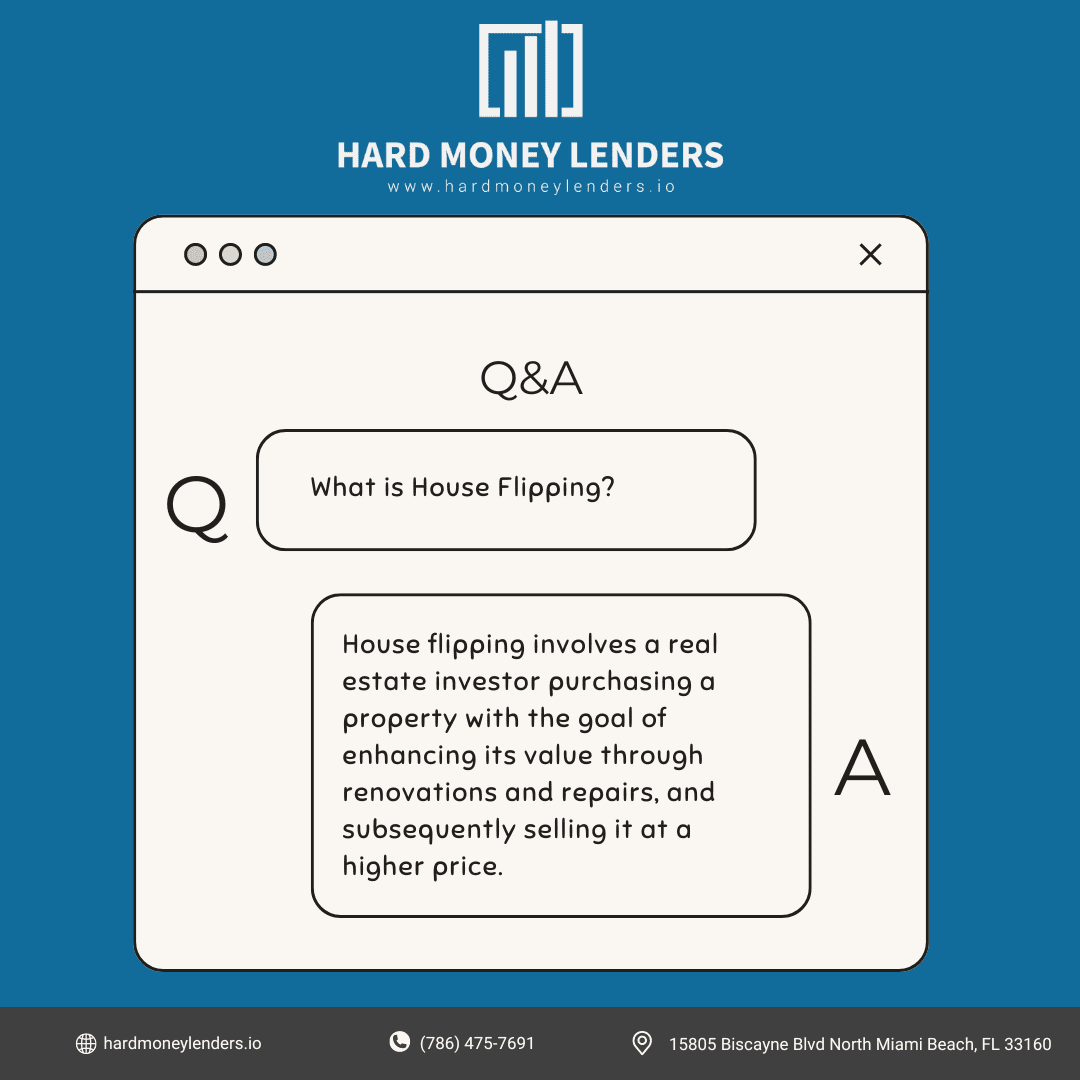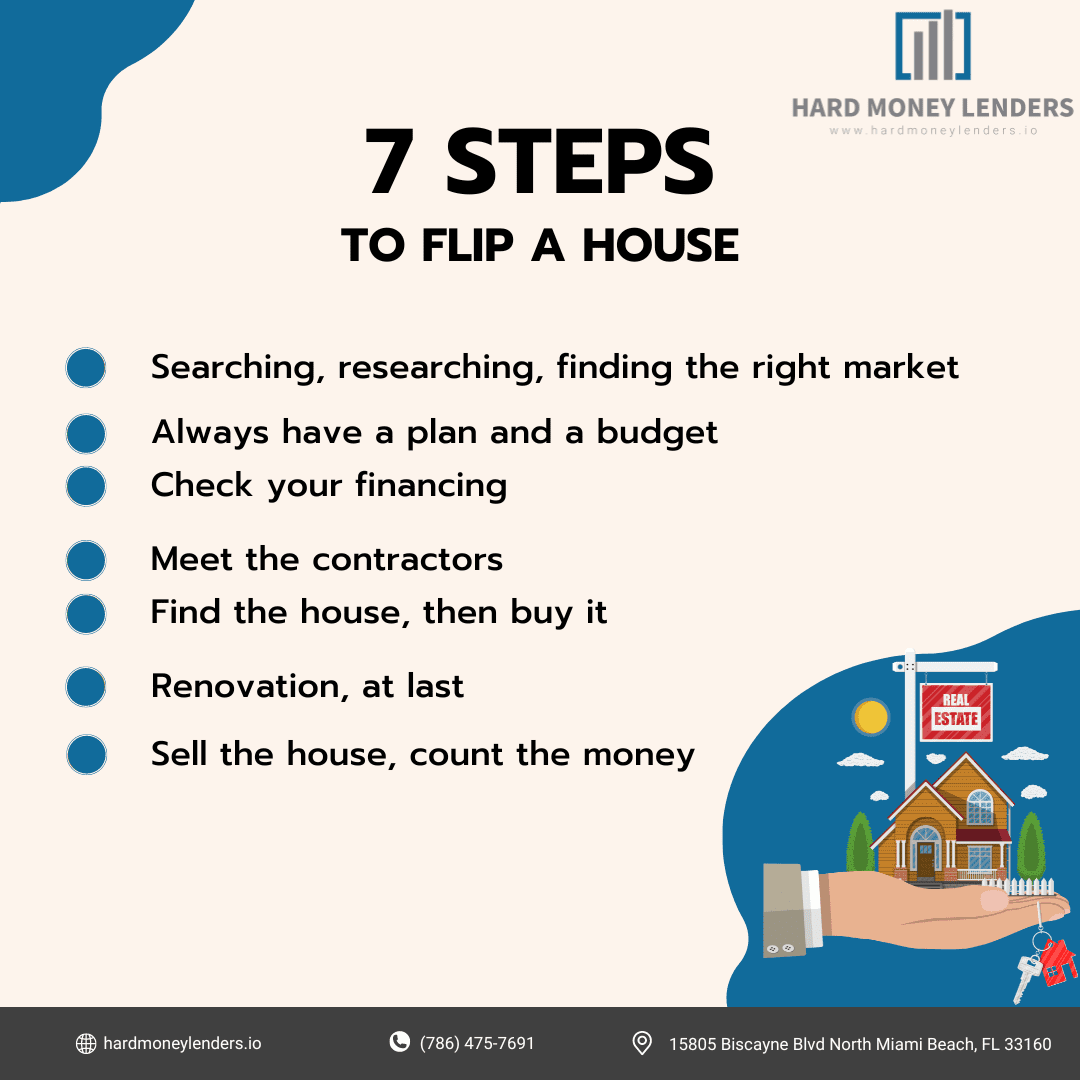How to Flip a House in 7 Simple Steps
We’ve all been there: watching one of those house flipper TV shows, fantasizing about making $50,000 in two weeks. Well, we all know the “reality” we see on TV isn’t quite accurate. Nevertheless, there’s a reason they don’t call it “fantasy”. Two weeks is certainly unrealistic, but real estate investors who flip homes (“house flippers”) can earn a serious profit in relatively little time. Let’s take a look at how to flip a house in 7 simple steps.
Don’t get too excited..
It goes without saying that flipping houses is hard work, and TV won’t show you the less romantic aspects: expect late nights spent poring over paperwork, a lot of time spent writing email and making phone calls, and potentially exhausting days if you take a hands-on approach in order to save money on labor.
There’s also a lot of inherent risk in house flipping, as with any investment. You could make fifty thousand dollars, but you could just as easily lose it. It’s not gambling, however: there are very real strategies you can use to mitigate the risks involved, and we highly recommend doing research and performing analyses before committing to a house flip.
Our seven steps will help you understand how to flip houses successfully, providing a foundation of knowledge before you invest tens of thousands of dollars. You could earn a hefty profit, but first, it’s important to look at exactly what house flipping entails, and determine whether it’s a business you would do well in.
What is House Flipping?

Flipping houses entails buying a property, renovating it, and selling it for a profit. You probably knew that much already, but let’s zoom in and look at the finer details.
House flippers purchase properties that most buyers aren’t willing to invest in, owing to the work they’ll take to succeed on the market. The average buyer wants a zero hassle home that comes ready for move-in, which means troubled properties are potentially valuable investments. There’s a huge market, and your role is to connect these comparatively inexpensive properties to buyers who aren’t willing to stomach the renovation process.
House Flipping Benefits
House flipping, while challenging, offers a suite of benefits that can appeal to both novice and seasoned investors in the real estate market. These benefits extend beyond mere profit, facilitating growth in personal competence, professional network, and market understanding.
- Enhanced Return on Investment: Flipping houses stands out for its potential to quickly generate high returns. Unlike traditional real estate investments that often yield returns over extended periods through appreciation or rental income, house flipping can provide substantial returns in a matter of months depending on the project’s scope and market conditions. This quick turnover allows investors to reinvest profits into new projects at a faster rate, compounding their earnings and increasing their investment portfolio’s value.
- Skill Acquisition and Professional Development: The process of flipping houses is intensive and varied, requiring a multitude of skills that are valuable both in and outside of real estate. Investors improve their project management skills, learning to oversee complex projects from inception to completion. They also gain practical knowledge in areas like budget management, construction, and real estate market analysis. These skills are not only applicable to other types of real estate investments but also enhance personal capabilities in managing budgets, negotiating contracts, and strategic planning.
- Broad Networking Opportunities: Successful house flipping involves collaboration with a range of professionals from different fields. Regular interactions with real estate agents, contractors, architects, and legal professionals can significantly broaden an investor’s professional network. These relationships are crucial for future projects and can lead to more favorable deals, partnerships, and insider knowledge on market trends and opportunities.
- In-Depth Market Understanding: Active engagement in house flipping provides investors with a nuanced understanding of the local real estate market. This insider knowledge is invaluable, enabling investors to identify undervalued properties, anticipate market shifts, and make informed decisions about when and where to invest. Such insights can give investors a competitive edge, allowing them to act quickly on opportunities that others might overlook.
- Foundation for a Scalable Business: For those who achieve consistent success in flipping houses, there is significant potential to scale this venture into a broader business. This might involve branching out into property development, launching a real estate investment group, or managing a portfolio of rental properties. Each of these pathways offers different challenges and rewards, contributing to a robust and diversified investment strategy.
The journey of flipping houses can be profoundly rewarding, providing financial gains, personal growth, and the opportunity to build a lasting impact in the real estate industry. However, it demands resilience, adaptability, and a thorough understanding of both the risks and rewards involved. Aspiring flippers should approach this venture with diligence and a readiness to learn, leveraging each project as an opportunity to enhance their skills and market knowledge.
Common Pitfalls and Concerns Of First-Time House Flippers
- Underestimating Costs. One major challenge for first-time house flippers is underestimating costs, which includes not just the immediate materials and labor but also extended expenses like permits, utility upgrades, and unexpected structural repairs. A critical oversight is not allocating a sufficient contingency fund, typically 10-20% of the budget, which is necessary for handling unforeseen costs and ensuring the project can be completed without compromising quality. This miscalculation can significantly erode profit margins, turning potential gains into losses.
- Overestimating the Property’s Value After Renovations. Novice flippers might set their expected resale price based on the highest market values or overly optimistic scenarios without considering the current market dynamics or potential downturns. It’s crucial to perform a comprehensive comparative market analysis to establish a realistic after-repair value (ARV). Overpricing can lead to prolonged market exposure and necessitate price reductions, which dilute the profitability of the flip.
- Time Management. Delays can occur due to various factors such as contractor availability, permit processing times, or material backorders, which extend the project timeline and subsequently increase carrying costs like mortgage interest, property taxes, and utilities. These extended costs can quickly add up, diminishing the overall return on investment.
- Navigating regulatory challenges is also a significant hurdle. Lack of familiarity with local building codes, permit requirements, and zoning laws can lead to costly delays, legal issues, and even project cessation. Ensuring compliance with all local regulations is essential to avoid fines and ensure that renovation efforts are not wasted.
- Managing contractors can be particularly daunting for those new to real estate investment. Without prior experience, it can be challenging to choose reliable contractors and manage them effectively. It’s important for flippers to thoroughly vet potential contractors by checking references, reviewing previous projects, and verifying licensing. Moreover, negotiating detailed contracts that outline clear expectations regarding timelines, payment schedules, and project scopes is critical to prevent misunderstandings and ensure quality workmanship.
By understanding and preparing for these pitfalls, first-time flippers can better navigate the complexities of real estate investment and increase their chances of success.
How to Flip a House in 7 Simple Steps

That’s the basic paradigm, anyway. The process itself starts with research and analysis, followed by purchasing and renovating a property, then successfully appealing to buyers in order to turn a profit. There are potential pitfalls all along the way, but with our seven steps, you should hopefully be able to avoid the worst of them.
Step 1: Searching, researching, finding the right market.
All markets aren’t created equal, at least not in the house flipping business. If you have a $10,000 budget, you shouldn’t spend too much time following high end markets where even problem properties could start at $500,000 or more. Investment property financing, such as hard money loans, can certainly cover the worst of your expenses— but keep in mind that lenders aren’t an unlimited pool to draw from. What resources do you have available right now? What markets can you afford to flip a house in?
Many investors divide real estate markets into “classes” of neighborhoods. Class A neighborhoods are affluent, consisting of expensive homes owned by wealthy professionals and business owners. Class B neighborhoods are one step down the economic ladder, but still fairly prosperous: these are your solidly middle class neighborhoods, comfortable, but not exactly rich.
Class C neighborhoods are blue collar, working class neighborhoods, but not necessarily a bad choice for investors with limited resources. On the other hand, Class D neighborhoods house the lowest-income residents, and in turn the properties themselves are often the lowest-income of the four classes.
Some house flippers specialize in Class D neighborhoods, but they come with additional risks that a beginner should likely steer clear of. These neighborhoods will often have higher insurance premiums, a consequence of generally elevated crime rates— and even if insurance does have you covered, break-ins or vandalism could seriously cut into your profits, not least of all by slowing the renovation process down. Keep in mind that many residents in these neighborhoods do not own their homes, and you will likely be selling any properties you flip to other investors. These investors tend to know the market very well, which means you could see slim profit margins. However, the flip side of that knowledge is that investors know exactly what and how they want to buy, meaning the sales process could go very quickly.
These neighborhoods can be profitable, but they aren’t for every investor. Consider looking at Class B or C neighborhoods, middle or working class areas with relatively affordable but safe investments. I know I’ve seen many investors regret losing money to the lower-end.
Tip: Your world isn’t limited to your hometown! Suburbs or smaller towns within about an hour’s distance could also be a good place to start, if you know the area well enough.
Step 2: Always have a plan and a budget.
As a real estate investor, and a house flipper no less, you’re in business. You’ll need a business plan, as would any entrepreneur.
You don’t need anything too fancy, certainly no pointless twenty minute meetings or corporate lingo; there doesn’t have to be any football-spiking or can-kicking to speak of. All you really need is a budget, a timeline, and a definite project scope.
How much do you have to invest? How much do you need in reserve? Do you have enough to cover renovation until the lender comes through?
What scope are you comfortable with? The best way to start out is with cosmetic updates. There are plenty of properties out there that are undervalued because of faded paint, dated shag carpeting, and a few dysfunctional fixtures here or there: you can turn a decent profit by updating kitchens and bathrooms, laying new paint and floors, and replacing those fixtures. These renovations are inexpensive and don’t take long.
You’ll want to think twice about houses with structural problems. These can be risky even for highly experienced investors, as it often takes more time and money than anticipated to fix these issues. Avoid mechanical issues, too; for your first flip, you’ll want to minimize the number of permits you have to deal with.
Your margins will be narrower than what TV shows you. You won’t make $50,000 in two weeks. However, with a little patience and determination, you can make sure these crucial early investments turn out well.
Step 3: Check your financing
You don’t want to see your offer approved only to struggle with finding the money to make it reality.
Before even making the offer, you’ll want to have a lender on hand to provide funds. Make sure to be aware of what that funding entails, too. The ideal loan has a reasonable interest rate, low fees, and a minimal wait. You may not be able to find the perfect loan, but you may be surprised what a good lender can do for you.
Keep in mind that your loan repayment period won’t be very long, so high interest rates aren’t a deal breaker if other fees are low. You’ll likely only ever make a few payments.
Step 4: Meet the contractors
You should start building relationships with contractors before you actually buy your first property. Knowing the right contractors can make all the difference, especially if you aren’t going to be working on the property yourself. The ideal case is to have a few competing quotes on the property before you buy.
You’ll want to have a few different business cards on hand, though you shouldn’t need all of them for a given flip. Electricians, roofers, plumbers, painters, and HVAC technicians are all good to know. It’s also worthwhile to familiarize yourself with lower-cost generalist handymen, too.
Step 5: Find the house, then buy it
Among the most important elements of a successful house flip is knowing how to find a good deal. You want to buy below market value in order to have wide margins that cover your expenses— you’re looking at two rounds of closing costs, carrying costs during renovation, realtor fees, and potentially a lot more.
There are many ways you can find undervalued properties to invest in. It’s important to research your market closely, especially keeping an eye on the possibility that any new amenities or employers could move in.
Part of it is patience. You may find yourself sending hundreds of letters, making dozens of offers, but only buying one property. It’s tedious, but finding the right deal is critical.
 Once you’ve found it, you need to buy it. Some lenders move faster than others, and hard money lenders in particular offer very fast-paced loans. The process takes time in any case, but you can minimize it by looking into hard money loans.
Once you’ve found it, you need to buy it. Some lenders move faster than others, and hard money lenders in particular offer very fast-paced loans. The process takes time in any case, but you can minimize it by looking into hard money loans.
You may want to hire a home inspector, for that matter: home inspections can be incredibly comprehensive, and an experienced inspector could help you make sure this property is a good idea.
If it seems like there aren’t any dangers lurking in the shadows, you’ll want to call a few contractors and tour the house with them. Ask for multiple quotes, and try to figure out which contractor offers the best service for the price.
In order to move as quickly as possible, it’s best to choose a contractor and schedule the start of renovations for the same day you settle on the property.
Step 6: Renovation, at last.
I would say it’s finally time for work to begin, but if you’re a careful investor, you’ve already put a lot of work in, haven’t you?
The contractors, however, will start work after the purchase. The clock is ticking now: every month comes with interest, taxes, utilities, and insurance. The faster you work, the less money you’ll burn.
Flipping houses has a lot to do with efficiency: you’ll need to choose your contractors wisely, and even then, monitor them carefully. Many contractors have been known to turn a week-long repair into a month-long repair. For that matter, some contractors will try to raise the project’s price after they’ve already started working. You may want to talk to past clients before deciding on a contractor, especially if you’re new to house flipping.
Step 7: Sell the house, count the money.
The seventh and final step is generally the simplest: selling.
This is largely a realtor’s domain, so if you’ve hired an experienced realtor, it shouldn’t take long at all.
However, your realtor isn’t everything. This is ultimately your property, and you need to make sure you’ve priced it responsibly. The 70% rule is a good place to start, even before the property is on the market.
If you feel confident, you may want to pursue a realtor’s license yourself. This could save you a few percentage points in fees, but it does take time and money.
In Conclusion…
Flipping a house is no small task, but by breaking it down into simple steps, it becomes very possible for a beginner to understand. It’s easier every time, too, as your professional network and experience grow.
Do your research, prepare accordingly, and don’t be afraid to act when the opportunity presents itself. You may not see reality TV returns, but with any luck, you’ll soon be seeing very real profits from house flipping. We all started somewhere, and with these seven steps, you can start from a position of confidence.
FAQs
What do I need to know before flipping a house?
- Market Analysis: Effective house flipping starts with a solid understanding of the local real estate market. Dive deep into current market conditions, focusing on factors like average days on market, selling prices versus asking prices, and neighborhood desirability. Research trends to determine if the market is appreciating, and identify neighborhoods that are in the process of revitalization, as they often present lucrative opportunities.
- Financial Planning: Start with a detailed budget that accounts for all potential costs: purchase price, estimated repair costs, carrying costs like insurance, property taxes, and utilities, as well as selling costs, including real estate agent fees and concessions to buyers. Prepare for unexpected expenses by setting aside a contingency budget of 10-20% of the estimated renovation costs.
- Renovation Scope: Identify renovations that significantly increase property value without being prohibitively expensive. Prioritize changes that appeal to the broadest audience, such as updating kitchens and bathrooms, enhancing curb appeal, and fixing any structural or systemic issues. Avoid over customization that reflects personal taste rather than mass appeal.
- Exit Strategy: Develop a clear exit strategy before purchasing the property. Decide on the pricing strategy considering the after-repair value (ARV), market conditions, and your desired profit margin. Plan your marketing strategy and choose whether you’ll sell directly, through an agent, or via real estate auctions depending on what’s best for maximizing return on investment.
What questions to ask when flipping a house?
- Assessing Property Value: Always start by estimating the after-repair value (ARV) of the property. This is what the home is expected to sell for once all renovations are complete. Compare this value against the purchase price plus renovation costs to ensure a profitable flip.
- Identifying Structural Issues: Thoroughly inspect the property for structural issues such as foundation cracks, old roofing, and outdated electrical or plumbing systems. Structural problems can significantly inflate the budget and delay the timeline.
- Renovation Requirements: Determine the scope of necessary renovations to make the property appealing to potential buyers. Ask yourself whether the property needs a simple cosmetic update or a full structural renovation. This will influence both your budget and timeline.
- Timeline and Costs: Estimate how long the renovations will take and how much they will cost. Accurate timelines and cost estimates are crucial for scheduling and budgeting. Factor in extra time and money for unforeseen issues that could arise during the renovation process.
- Local Market Conditions: Understand the specific dynamics of the neighborhood. Are property values in the area rising? What are the selling points of the neighborhood? Is there demand for real estate in this area? This knowledge can guide your renovation choices and marketing strategy.
What is the golden rule for flipping houses?
The golden rule for flipping houses—never overpay for the property—is crucial for ensuring profitability. Adhering to the 70% rule is a commonly used strategy among seasoned flippers. This rule states that an investor should purchase a property for no more than 70% of its After Repair Value (ARV), minus the costs of any repairs and renovations needed. This calculation helps ensure that you maintain a buffer to cover unexpected expenses and still make a profit, considering the market fluctuations and other investment risks. By sticking to this rule, flippers can protect themselves against overinvesting in a property that may not yield the expected return on the open market.
How long should a house flip take?
The ideal timeline for a house flip can vary, but most successful flips are completed within 3 to 6 months. This timeframe includes purchasing the property, carrying out renovations, and selling the home. Quick turnovers are essential in flipping because longer holding periods can lead to increased holding costs such as taxes, insurance, and loan interest, which can erode profits. Efficient project management, timely execution of renovations, and a streamlined selling process are vital to keeping within this timeframe. Delays can be minimized by thorough upfront planning, having a reliable team of contractors, and ensuring that financing and real estate market conditions are conducive to quick sales.
How do house flippers avoid taxes?
House flippers can employ several tactics to minimize tax liabilities, enhancing the overall profitability of their projects:
- Capital Gains Strategy: Profits from flipped properties are typically subject to capital gains taxes. Holding a property for more than one year can qualify the gains as long-term, which are taxed at a lower rate than short-term capital gains.
- 1031 Exchange: This tax deferment strategy allows investors to defer paying capital gains taxes on investment properties by reinvesting the proceeds from a sale into another property. This process can be repeated to continue deferring taxes but requires adherence to specific IRS rules.
- Deductions for Business Expenses: Flippers can deduct legitimate business expenses related to the flip, such as costs for renovations, marketing, and travel, directly from their taxable income. This reduces the overall taxable profit from the flip.
Can flipping houses be passive income?
Flipping houses is generally considered an active form of income because it requires significant involvement in terms of finding properties, managing renovations, and navigating the sales process. Unlike passive income streams, which typically require minimal day-to-day involvement once set up, flipping demands ongoing decision-making and physical or managerial activity. However, an investor could potentially reduce their hands-on involvement by hiring a team to manage these tasks, but the IRS still usually categorizes flipping as active income due to the nature and intent of the investment activity.

Yuval Elkeslasi is a distinguished professional in the finance industry, celebrated for his pioneering strategies and significant contributions as the leader of Hard Money Lenders IO. Hailing from Queens, New York, Yuval has built an impressive career, transforming the lending landscape through his expertise and visionary approach. Yuval Elkeslasi
attended Florida State University, where he obtained a bachelor’s degree in Finance. This academic foundation provided him with the necessary skills and knowledge to thrive in the competitive financial arena. Yuval’s tenure at Hard Money Lenders IO is marked by numerous pioneering accomplishments. He has introduced a variety of loan programs designed to cater to specific client requirements, including fix and flip loans, new construction financing, cash-out refinancing, rental property loans, and specialized financing for luxury items like yachts. Among Yuval’s significant achievements is securing an $8 million construction loan for a spec home builder in Port Royal, Naples. He also orchestrated the financing for a prestigious 72’ 2024 Viking Convertible yacht valued at $7.2 million. These transactions demonstrate Yuval’s adeptness at navigating complex financial landscapes and delivering exceptional results.
